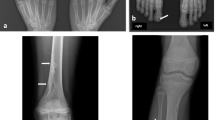Abstract
Trichothiodystrophy (TTD) is a rare, autosomal recessive, multisystem disorder associated with defects in nucleotide excision repair. We report a 7-year-old boy with TTD due to mutation in the XPD gene. The patient has classic features of this condition, including brittle, sulphur-deficient hair, ichthyosis, growth retardation and developmental delay. In addition, he has radiological evidence of progressive central osteosclerosis. Although similar radiological findings have previously been reported in a small number of patients, this association is not widely recognised. We review the radiological findings in this and other similar cases and discuss the natural history of these bony changes.






Similar content being viewed by others
References
Tolmie JL, de Berker D, Dawber R, et al (1994) Syndromes associated with trichothiodystrophy. Clin Dysmorphol 3:11–14
Botta E, Nardo T, Lehman AR, et al (2002) Reduced level of the repair/transcription factor TFIIH in trichothiodystrophy. Hum Mol Genet 11:2919–2928
Chapman S (1988) The trichothiodystrophy syndrome of Pollitt. Pediatr Radiol 18:154–156
Civitelli R, McAlister WH, Teitelbaum SI, et al (1989) Central osteosclerosis with ectodermal dysplasia: clinical, laboratory, radiologic and histopathologic characterisation with review of the literature. J Bone Miner Res 4:863–875
McCuaig C, Marcoux D, Ramussen JE, et al (1993) Trichothiodystrophy associated with photosensitivity, gonadal failure, and striking osteosclerosis. J Am Acad Dermatol 28:820–826
Battistella PA, Peserico A (1996) Central nervous system dysmyelination in PIBI(D)S syndrome: a further case. Childs Nerv Syst 12:110–113
Wenz W, Saleh H, Perlick C (1999) Orthopaedic rehabilitation in a case of Tay syndrome. Pediatr Rehabil 3:133–135
Toelle SP, Valsangiacomo E, Bolthauser E (2001) Trichothiodystrophy with severe cardiac and neurological involvement in two sisters. Eur J Pediatr 160:728–731
Kobayashi T, Uchiyama M, Fukuro S, et al (2002) Mutations in the XPD gene in xeroderma pigmentosum group D cell strains: confirmation of genotype-phenotype correlation. Am J Med Genet 110:248–252
Silengo CM, Franceschini P, Bianco R, et al (1986) Distinctive skeletal dysplasia in Cockayne syndrome. Pediatr Radiol 16:264–266
Viprakasit V, Gibbons RJ, Broughton BC, et al (2001) Mutations in the general transcription factor TFIIH result in β-thalassaemia in individuals with trichothiodystrophy. Hum Mol Genet 10:2797–2802
de Boer J, Andressoo JO, de Wit J, et al (2002) Premature aging in mice deficient in DNA repair and transcription. Science 296:1276–1279
Johnson F, Flores C, Dodgson WB (1978) Case report 50. Skeletal Radiol 2:185–186
Dowd PM, Muro DD (1983) Ichthyosis and osteopetrosis. J R Soc Med 76:423–426
Acknowledgements
We would particularly like to thank the family for their cooperation with this case report. We are also grateful to Professor Alan Lehman who carried out the DNA repair studies and mutation analysis and to Dr Richard Gibbons for his work on the haematological phenotype in this patient. Part of this work was undertaken by Great Ormond Street Hospital for Children NHS Trust, which received a proportion of its funding from the NHS Executive. The views expressed in this publication are those of the authors and are not necessarily those of the NHS Executive.
Author information
Authors and Affiliations
Corresponding author
Rights and permissions
About this article
Cite this article
Wakeling, E.L., Cruwys, M., Suri, M. et al. Central osteosclerosis with trichothiodystrophy. Pediatr Radiol 34, 541–546 (2004). https://doi.org/10.1007/s00247-004-1207-7
Received:
Revised:
Accepted:
Published:
Issue Date:
DOI: https://doi.org/10.1007/s00247-004-1207-7




